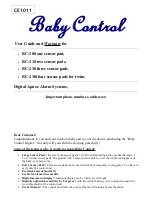
The smaller hole
Â
on the nut plate should line up with the
smaller hole on the template.
11
If the smaller 3.6 mm (
9
/
64
in.) hole on the nut plate does not
line up with the smaller hole on the template, mark the new
location.
12
Repeat steps 10 and 11 for each nut plate.
13
Using a 3.6 mm (
9
/
64
in.) drill bit, drill the smaller holes.
14
Starting in one corner of the mounting location, place a nut
plate
Ã
on the back of the mounting surface, lining up the
large and small holes.
The raised portion of the nut plate should fit into the larger
hole.
15
Secure the nut plate to the mounting surface by fastening an
M3 screw
Ä
through the smaller 3.6 mm (
9
/
64
in.) hole.
16
Repeat steps 14 and 15 for each of the nut plates along the
top and bottom of the device.
17
Remove the template from the mounting surface.
18
If you will not have access to the back of the device after you
mount it, connect all necessary cables to the device before
placing it into the cutout.
19
To prevent corrosion of the metal contacts, cover unused
connectors with the attached weather caps.
20
Apply marine sealant between the mounting surface and the
device to properly seal and prevent leakage behind the
dashboard.
21
If you will have access to the back of the device, apply
marine sealant around the cutout.
22
Place the device into the cutout.
23
Secure the device to the mounting surface using M4 screws
Å
or wood screws, depending on the mounting method.
24
Wipe away all excess marine sealant.
25
Install the decorative bezel by snapping it in place around the
edges of the device.
Connection Considerations
When connecting this device to power and to other Garmin
®
devices, you should observe these considerations.
• The power and ground connections to the battery must be
checked to make sure they are secured and cannot become
loose.
• The cables may be packaged without the locking rings
installed. The cables should be routed before the locking
rings are installed.
• After installing a locking ring on a cable, you should make
sure the ring is securely connected and the o-ring is in place
so the power or data connection remains secure.
Connecting to Power
WARNING
When connecting the power cable, do not remove the in-line
fuse holder. To prevent the possibility of injury or product
damage caused by fire or overheating, the appropriate fuse
must be in place as indicated in the product specifications. In
addition, connecting the power cable without the appropriate
fuse in place voids the product warranty.
1
Route the power cable to the power source and to the device.
2
Connect the red wire to the positive (+) battery terminal, and
connect the black wire to the negative (-) battery terminal.
3
Connect the power cable to the device, and turn the locking
ring clockwise to tighten it.
Additional Grounding Considerations
This device should not need any additional chassis grounding in
most installation situations. If interference is experienced, the
grounding screw on the housing can be used to connect the
device to the water ground of the boat to help avoid the
interference.
Power Cable Extensions
If necessary, the power cable can be extended using the
appropriate wire gauge for the length of the extension.
Item Description
À
Fuse
Á
12 Vdc power source
Â
Command Link Plus
®
and Helm Master
®
bus network connector
Ã
0183 Connection Considerations
Ä
2.4 m (7.9 ft.) no extension
Item Description
À
Splice
Á
• 10 AWG (5.26 mm²) extension wire, up to 4.6 m (15 ft.)
• 8 AWG (8.36 mm²) extension wire, up to 7 m (23 ft.)
• 6 AWG (13.29 mm²) extension wire, up to 11 m (36 ft.)
Â
Fuse
Ã
20.3 cm (8 in.)
Ä
12 Vdc power source
Å
2.4 m (7.9 ft.)
Æ
0183 Connection Considerations
Ç
Command Link Plus and Helm Master bus network connector
2






















